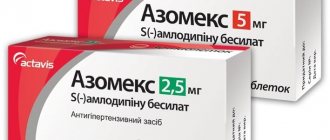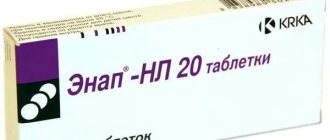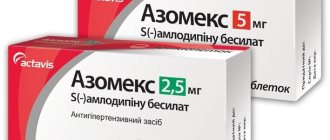Pharmacodynamics and pharmacokinetics
( INN: Lisinopril) is considered an angiotensin-converting factor inhibitor and can interrupt the chain formed from angiotensin II to I. Lisinopril reduces the level of the vasoconstrictor effect of the substance - angiotensin II , while the concentration of aldosterone in the bloodstream decreases.
Lisinopril helps reduce the volume of atrial resistance. The drug Diroton, its use to lower blood pressure, does not affect the heart rate (HR) and leads to an increase in minute blood volume, as well as renal blood flow. To achieve the maximum effect, 6 hours are needed. In the future, it lasts for about a day and may vary depending on the dosage of the drug. Diroton from pressure with prolonged use reduces its effectiveness.
Pharmacokinetic data
The absorption process occurs from the gastrointestinal tract, then lisinopril , entering the blood plasma, does not bind to proteins. Typically, bioavailability is no more than 25-30%, and the diet does not change the rate of absorption. The drug is removed after 12 hours. Since the active substance is not metabolized, it is excreted unchanged in the urine. The drug Diroton does not cause withdrawal syndrome if therapy is abruptly stopped.
Pharmacological properties of the drug Diroton
Lisinopril (N-[N-[(IS)-1-carboxy-3-phenylpropyl]-L-lysyl]-L-proline dihydrate) belongs to the group of ACE inhibitors. Reduces the level of angiotensin II and aldosterone in the blood plasma, as a result of which OPSS decreases, IOC increases, heart rate does not change, and renal perfusion may increase. The hypotensive effect is dose-dependent, occurs approximately 1 hour after administration, reaches a maximum after approximately 6 hours and persists for 24 hours. With long-term treatment, the effectiveness of lisinopril remains. When suddenly stopping the drug, no withdrawal syndrome was observed. After oral administration, it is absorbed unchanged; food intake does not affect the absorption of the drug. In addition to ACE, it does not bind to other plasma proteins. The bioavailability of lisinopril is 25–50%. The maximum concentration in blood plasma is reached after approximately 7 hours. It is not metabolized in the body and is excreted by the kidneys. The half-life is 12 hours.
Indications for use of Diroton
- the drug is effective in chronic heart failure (as part of combination therapy);
- if it is necessary to prevent left ventricular dysfunction , heart failure , as well as maintain stable hemodynamic Diroton tablets are used - for which they are effective, incl. in acute myocardial infarction ;
- for diabetic nephropathy (reduces albuminuria );
- indications for the use of Diroton tablets also include essential and renovascular hypertension (as monotherapy or combination treatment with other antihypertensive drugs).
Contraindications
- a history of idiopathic angioedema , including cases with the use of ACE inhibitors ;
- Quincke's edema hereditary;
- minors (≤ 18 years old);
- pregnant and breastfeeding women;
- known hypersensitivity to the current lisinopril or auxiliary components, as well as to other ACE inhibitors .
The blood pressure medicine Diroton has instructions for use with caution
- with stenosis of the renal arteries or aortic mouth ;
- after kidney transplantation ;
- patients with renal failure with CC less than 30 ml/min;
- for obstructive hypertrophic cardiomyopathy ;
- at the primary stage of hyperaldosteronism ;
- with arterial hypotension ;
- patients with cerebrovascular diseases or cerebrovascular insufficiency;
- severe forms of diabetes mellitus ;
- for scleroderma , ischemic heart disease , systemic lupus erythematosus ;
- severe chronic heart failure;
- patients with depressed bone marrow hematopoiesis;
- in a hypovolemic state , with hyponatremia ;
- elderly patients;
- persons on hemodialysis with high-flow dialysis membranes (AN69) , as an anaphylactic reaction .
Special instructions for the use of Diroton
Symptomatic hypotension may occur in patients receiving diuretic treatment, or with dehydration of other origins (excessive sweating, prolonged vomiting, profuse diarrhea), as well as with heart failure. If symptomatic hypotension occurs, it is recommended to put the patient to bed and, if necessary, administer an infusion of isotonic sodium chloride solution. Before starting treatment, if possible, the level of sodium in the blood serum should be normalized, the lost volume of fluid should be replaced, and blood pressure should be monitored. With renal artery stenosis (especially with bilateral stenosis or stenosis of the artery of a single kidney), as well as with dehydration, the use of Diroton can lead to impaired renal function up to acute renal failure, which is usually reversible and goes away after discontinuation of the drug. Taking the drug (especially at the beginning of treatment) may affect the ability to drive vehicles and perform hazardous work, so you should refrain from such activities until your individual response is determined. During extensive surgical interventions or the use of anesthesia that can cause arterial hypotension, Diroton blocks the formation of angiotensin II, which occurs after the compensatory release of renin. Hypotension resulting from the above mechanism can be eliminated by replacing the volume of intravascular fluid. Particular care must be taken when determining the dose of the drug in elderly patients. Due to the fact that the potential risk of agranulocytosis cannot be completely eliminated, periodic monitoring of peripheral blood is necessary when using the drug.
Side effects
These blood pressure pills can cause undesirable reactions such as dizziness and headaches (in approximately 5-6% of patients), possible weakness, diarrhea, skin rash, nausea, vomiting, dry cough (in 3%), orthostatic hypotension , chest pain (in 1-3%).
Other side effects with an incidence of less than 1% can be divided according to the organ systems from which they occur:
- CVS: decreased blood pressure, tachycardia , bradycardia , manifestations of heart failure, impaired atrioventricular conduction, possible myocardial infarction .
- Digestive system: anorexia , dry mouth, indigestion, impaired sense of taste, development of pancreatitis , hepatitis , jaundice , hyperbilirubinemia , increased activity of liver enzymes - transaminases.
- Skin: urticaria , increased sweating, photosensitivity , alopecia , itching.
- Central nervous system: sudden changes in mood, impaired attention, paresthesia , fatigue and drowsiness, confusion, cramps of the limbs and lips, asthenic syndrome .
- Respiratory system: apnea , dyspnea , bronchospasm .
- Hematopoietic system: neutropenia , leukopenia , thrombocytopenia , agranulocytosis , anemia .
- Immune system: vasculitis , angioedema , positive reaction (screening) to antinuclear antibodies , increased ESR , eosinophilia .
- Genitourinary system: decreased potency, anuria , uremia , oliguria , renal dysfunction up to acute renal failure.
- Metabolism: increased or decreased potassium content in the blood, decreased concentration of sodium, magnesium, chlorine, increased concentration of calcium, uric acid , urea , creatinine , cholesterol , hypertriglyceridemia .
- Among others: arthralgia , fever , arthritis , myalgia , exacerbation of gout .
Instructions for use DIROTON® (DIROTON®)
Symptomatic hypotension
Symptomatic hypotension rarely occurs in patients with uncomplicated hypertension. In patients with arterial hypertension while taking lisinopril, arterial hypotension is more likely to occur against the background of hypovolemia, for example, when using diuretics, limiting sodium in the diet, during dialysis, diarrhea or vomiting, or the presence of severe renin-dependent hypertension. In patients with heart failure, regardless of the presence of concomitant renal failure, the development of symptomatic hypotension was observed. Symptomatic hypotension is most likely to develop in patients with more severe heart failure, in which higher doses of loop diuretics are used, hyponatremia, or functional renal failure. In patients at increased risk of developing symptomatic hypotension, careful monitoring of the condition is necessary when initiating therapy or when adjusting the dose. The same applies to patients with coronary artery disease or cerebrovascular disease, in whom an excessive decrease in blood pressure can lead to myocardial infarction or cerebrovascular accident.
If arterial hypotension occurs, the patient should be placed in a horizontal position; if necessary, intravenous infusion of 0.9% sodium chloride solution is recommended. Transient arterial hypotension is usually not a contraindication for further treatment; further treatment usually proceeds without complications after blood pressure is restored as a result of correction of hypovolemia.
In some patients with heart failure and normal or low blood pressure, an additional reduction in systemic blood pressure may be possible with the use of lisinopril. This effect is expected and is not a reason to stop treatment. If hypotension leads to clinical manifestations, dose reduction or discontinuation of lisinopril may be indicated.
Arterial hypotension in acute myocardial infarction
In the event of acute myocardial infarction, if treatment with vasodilators may seriously worsen hemodynamic status (eg, if systolic blood pressure is 100 mm Hg or lower, or in the case of cardiogenic shock), lisinopril is contraindicated. During the first 3 days after myocardial infarction, it is necessary to reduce the dose if systolic blood pressure is 120 mmHg. Art. or lower. Maintenance doses should be reduced to 5 mg or temporarily to 2.5 mg if systolic blood pressure is 100 mmHg. Art. or lower. In case of persistent arterial hypotension (systolic blood pressure below 90 mm Hg for more than 1 hour), lisinopril should be discontinued.
Aortic and mitral valve stenosis/hypertrophic cardiomyopathy
As with other ACE inhibitors, lisinopril should be used with caution in patients with mitral valve stenosis and left ventricular outflow tract obstruction, such as aortic valve stenosis or hypertrophic cardiomyopathy.
Renal dysfunction
In case of impaired renal function (creatinine clearance <80 ml/min), the initial dose of lisinopril should be adjusted depending on the plasmatic clearance (see table 1), and then on the patient’s clinical response to therapy. Routine monitoring of serum potassium and creatinine concentrations is part of standard medical practice in treating these patients.
In patients with heart failure, hypotension following administration of ACE inhibitors may lead to further deterioration of renal function. Acute renal failure, usually reversible, has been reported in this situation.
In some patients with bilateral renal artery stenosis or solitary renal artery stenosis treated with ACE inhibitors, increases in blood urea and serum creatinine were observed, usually reversible after discontinuation of therapy. This effect is more likely to occur in patients with renal impairment. In the presence of concomitant renovascular hypertension, the risk of severe arterial hypotension and renal failure increases. In such patients, treatment should be initiated under close medical supervision, using low doses and carefully titrating the dose. Because Diuretics may aggravate this condition and should be discontinued during the first weeks of lisinopril therapy and renal function monitored.
In some patients with arterial hypertension who do not have any concomitant renal vascular disease, increases in serum urea and creatinine concentrations have been observed, usually mild and short-lived, especially with simultaneous use of lisinopril and a diuretic. This effect is more likely to occur in patients with renal impairment. A dose reduction and/or discontinuation of the diuretic and/or lisinopril may be required.
Treatment with lisinopril should not be started in acute myocardial infarction in patients with impaired renal function with a serum creatinine concentration of more than 177 µmol/l and/or proteinuria exceeding 500 mg/24 hours. In the case of renal impairment that develops during treatment (creatinine concentration in serum level above 265 µmol/L or twice the initial level), discontinuation of lisinopril should be considered.
Hypersensitivity/angioedema (Quincke's edema)
In rare cases, angioedema of the face, extremities, lips, tongue, glottis and/or larynx has been reported with the use of ACE inhibitors, including lisinopril. Swelling may develop at any time during treatment. In this case, you must immediately discontinue lisinopril. The patient should receive appropriate treatment and be under medical supervision in a hospital until symptoms are completely resolved. Even if swelling appears only in the tongue area, without concomitant respiratory dysfunction, the patient may require long-term observation, because Therapy with antihistamines and corticosteroids may not be sufficient.
In very rare cases, death has been reported due to the development of angioedema of the larynx or tongue. Patients with involvement of the tongue, glottis, or larynx are at higher risk of airway obstruction, especially in the presence of airway surgery. In such cases, emergency treatment is indicated, which may include the administration of epinephrine and/or maintaining a patent airway. The patient should be under strict medical supervision until complete and sustained resolution of symptoms.
ACE inhibitors are more likely to cause angioedema in black patients than in patients of other races.
Patients who have previously had angioedema not associated with treatment with ACE inhibitors may be at greater risk of developing angioedema while taking an ACE inhibitor.
Anaphylactoid reactions in patients on hemodialysis
Anaphylactoid reactions have been reported in patients undergoing hemodialysis using high-flux, high-permeability dialysis membranes (eg, AN69) and concomitantly receiving an ACE inhibitor. In such patients, consideration should be given to using a different type of dialysis membrane or a different class of antihypertensive drug.
Anaphylactoid reactions during LDL apheresis
In rare cases, life-threatening anaphylactoid reactions may develop in patients receiving ACE inhibitors during LDL apheresis using dextran sulfate. Such reactions were avoided if the ACE inhibitor was temporarily stopped before each apheresis.
Desensitization
During desensitization (eg, insect venom) in patients receiving ACE inhibitors, persistent anaphylactoid reactions are observed. In the same patients, the occurrence of such reactions was avoided when therapy with ACE inhibitors was temporarily suspended, but they reappeared when accidentally taking these drugs.
Liver failure
In very rare cases, during therapy with ACE inhibitors, a syndrome has developed that begins with cholestatic jaundice and progresses to fulminant necrosis and (sometimes) leading to death. The mechanism of development of this syndrome has not been studied. If signs of jaundice appear or if liver enzyme activity increases significantly, treatment with lisinopril should be discontinued. The patient must be under appropriate medical supervision.
Neutropenia/agranulocytosis
Neutropenia/agranulocytosis, thrombocytopenia and anemia have been reported in patients receiving ACE inhibitors. In patients with normal renal function without other aggravating factors, neutropenia rarely develops. Neutropenia and agranulocytosis disappeared after cessation of treatment with ACE inhibitors. Lisinopril should be used with extreme caution in patients with collagen vascular disease, as well as in patients receiving immunosuppressive therapy, allopurinol or procainamide, or a combination of these complicating factors, especially if renal impairment is also present. Some of these patients developed serious infections, which in some cases did not respond to intensive antibiotic therapy. If lisinopril is used in such patients, periodic monitoring of white blood cell counts is recommended; In addition, patients should be taught the need to report any signs of infection.
Double blockade of the RAAS
There is evidence that the concomitant use of ACE inhibitors, angiotensin II receptor antagonists or aliskiren increases the risk of arterial hypotension, hyperkalemia and decreased renal function (including acute renal failure). Double blockade of the RAAS through the combined use of ACE inhibitors, angiotensin II receptor antagonists or aliskiren is not recommended for this reason.
If double blockade is absolutely necessary, treatment should be carried out under medical supervision with frequent close monitoring of renal function, electrolytes and blood pressure. In patients with diabetic nephropathy, combination therapy with ACE inhibitors and angiotensin II receptor antagonists should not be used.
Race
In black patients, ACE inhibitors cause angioedema more often than in patients of other races. As with other ACE inhibitors, lisinopril may be less effective in lowering blood pressure in black patients than in patients of other races, which is likely due to the higher incidence of low renin conditions in black patients with arterial hypertension. hypertension.
Cough
Cough has been reported during treatment with ACE inhibitors. The cough is usually dry, persistent, and stops after discontinuation of the drug. In the differential diagnosis of cough, the possibility of cough induced by ACE inhibitors should be considered.
Surgery/anesthesia
During major surgery or general anesthesia with the use of drugs that provoke the development of arterial hypotension, lisinopril can block the formation of angiotensin II after a compensatory release of renin. If arterial hypotension develops as a result of the above mechanism, correction can be made by increasing the volume of blood volume.
Hyperkalemia
Increases in serum potassium levels have been observed in some patients receiving ACE inhibitors, including lisinopril. The risk of hyperkalemia is greater in patients with renal insufficiency, diabetes mellitus, concomitant use of potassium-sparing diuretics, dietary supplements or salt substitutes containing potassium, and in patients taking drugs that may increase serum potassium levels (eg, heparin). If simultaneous use of the above drugs is mandatory, regular monitoring of serum potassium levels is recommended.
Patients with diabetes mellitus
In patients with diabetes mellitus, more careful monitoring of glucose concentrations is required in the first month of treatment with an ACE inhibitor in addition to previous treatment with insulin or oral hypoglycemic drugs.
Lithium preparations
As a rule, simultaneous use of lithium and lisinopril is not recommended.
Impact on the ability to drive vehicles and operate machinery
When driving vehicles or operating machinery, the possible development of dizziness or fatigue should be taken into account.
Diroton tablets, instructions for use (Method and dosage)
The medicine is taken orally once a day, regardless of diet, preferably at approximately the same time of day.
For essential hypertension
If therapy with other antihypertensive drugs , then the initial daily dose should not exceed 10 mg, maintenance is usually raised to 20 mg. After studying the dynamics, it can be increased to a maximum of 40 mg, taking into account that the full development of the effect is observed in 2–4 weeks. If the patient's therapeutic effect is not sufficiently pronounced, then therapy is supplemented with another antihypertensive drug .
Attention! Before taking Diroton, it is necessary to discontinue diuretic approximately 2-3 days in advance, otherwise the initial dose of Diroton should not exceed 5 mg/day. Treatment is carried out under medical supervision due to the risk of developing symptomatic arterial hypotension .
For renovascular hypertension and other conditions caused by increased activity of the RAAS hormonal system
It is recommended to begin therapy with a daily dose of 2.5–5 mg/day, preferably in a hospital under enhanced monitoring, including monitoring of blood pressure , renal function, and serum potassium concentration. The maintenance dose is determined based on monitoring the dynamics of blood pressure.
People with renal failure
Dose adjustment is required, which is based on regular assessment of creatinine clearance. So, at a Cl of 30–70 ml/min, treatment begins with 5–10 mg of lisinopril per day, at 10–30 ml/min – 2.5–5 mg/day.
hemodialysis patients should not exceed 2.5 mg.
For chronic heart failure
The initial daily dose is 2.5 mg, which can be gradually increased after 3-5 days to a standard maintenance dose of 5 to 20 mg. If diuretics , then their dose is reduced to the maximum possible. Treatment should begin with a study and be subsequently accompanied by monitoring of blood pressure , renal function, potassium and sodium concentrations, which will prevent the development of arterial hypotension , as well as impaired renal function.
For diabetic nephropathy
The recommended daily dose is 10 mg, which can be increased to a maximum of 20 mg. This gives a lasting reduction in diastasis. Blood pressure up to 75 mm Hg, which should be measured with the patient in a sitting position.
Instructions for use of Diroton for patients who have suffered acute myocardial infarction
On day 1 after a myocardial infarction, the patient is given an initial dose of 5 mg, on day 2 - again 5 mg, on day 3 - 10 mg, continuing treatment with a maintenance daily dose of no more than 10 mg for 6 weeks. If patients have low systemic blood pressure , it is recommended to start treatment with a lower dose of 2.5 mg.
Diroton®
Symptomatic hypotension
A pronounced decrease in blood pressure most often occurs when there is a decrease in circulating blood volume, for example, due to taking diuretics, a salt-restricted diet, dialysis, diarrhea or vomiting. In patients with CHF and with or without renal failure, a pronounced decrease in blood pressure is possible. It is more often detected in patients with severe CHF, as a result of the use of large doses of diuretics, hyponatremia or impaired renal function. In such patients, treatment should be started under strict medical supervision (with caution in selecting the dose of the drug and diuretics). The same recommendations apply to patients with coronary heart disease and cerebrovascular insufficiency, in whom a sharp decrease in blood pressure can lead to myocardial infarction or stroke.
Transient arterial hypotension is not a contraindication for taking the next dose of the drug. Before starting treatment, if possible, the circulating blood volume and/or sodium content in the blood serum should be replenished, and the condition of patients who are at increased risk of developing symptomatic hypotension should be carefully monitored at the beginning of treatment and when adjusting the dose. If arterial hypotension develops, the patient should be placed in the supine position and, if necessary, given an intravenous infusion of saline. A transient hypotensive reaction is not a contraindication to subsequent use of Diroton®, which can usually be used immediately after an increase in blood pressure following an increase in blood volume.
Arterial hypotension in acute myocardial infarction
Treatment with Diroton® is contraindicated in cases of cardiogenic shock and acute myocardial infarction, if the administration of a vasodilator can significantly worsen hemodynamic parameters, for example, when systolic blood pressure does not exceed 100 mm Hg. Art.
In acute myocardial infarction, treatment with lisinopril should not be initiated in patients with signs of renal dysfunction, defined as a serum creatinine concentration greater than 177 μmol/L and/or proteinuria greater than 500 mg/24 hours. In case of development of renal dysfunction during therapy with lisinopril (serum creatinine concentration exceeding 265 µmol/l or twice the corresponding value before the start of treatment), the physician should consider the advisability of discontinuing lisinopril.
Aortic and mitral valve stenosis/hypertrophic cardiomyopathy
As with other ACE inhibitors, lisinopril should be administered with caution to patients with mitral valve stenosis and left ventricular outflow tract obstruction such as aortic stenosis or hypertrophic cardiomyopathy.
Kidney failure
In case of renal failure (creatinine clearance < 80 ml/min), the initial dose of lisinopril should be adjusted depending on the patient's creatinine clearance and then depending on the patient's response to treatment. Routine monitoring of serum potassium and creatinine concentrations is part of standard medical practice in treating these patients.
In some patients with bilateral renal artery stenosis or with arterial stenosis of a solitary kidney who received ACE inhibitors, increases in serum urea and creatinine concentrations were observed, usually reversible when treatment was discontinued. This is especially likely in patients with kidney failure. In the case of concomitant renovascular hypertension, there is an increased risk of developing severe arterial hypotension and renal failure. In such patients, treatment should be initiated under close medical supervision at low doses and the dose titrated carefully. Since treatment with diuretics may contribute to the development of the above conditions, the diuretic should be discontinued and renal function should be monitored during the first weeks of lisinopril therapy.
In some patients with arterial hypertension without significant preexisting renovascular hypertension, an increase in serum urea and creatinine concentrations was observed, usually slight and transient, especially in cases where lisinopril was used concomitantly with a diuretic. This is especially likely in patients with pre-existing renal failure. A dose reduction and/or discontinuation of the diuretic and/or lisinopril may be required.
Hypersensitivity, angioedema
Angioedema of the face, extremities, lips, tongue, epiglottis and/or larynx has been reported rarely in patients treated with ACE inhibitors, including Diroton®.
Angioedema may occur at any time during treatment. In such cases, you should immediately discontinue the drug Diroton®, prescribe appropriate treatment and provide medical supervision until symptoms completely resolve. Even in cases of tongue swelling not accompanied by respiratory failure, patients may require long-term observation as treatment with antihistamines and corticosteroids may not be sufficient.
Angioedema, accompanied by swelling of the larynx, can be fatal. Swelling of the tongue, vocal folds, or larynx can lead to airway obstruction. When such symptoms appear, emergency treatment is required: administration of epinephrine (0.3-0.5 ml of epinephrine (adrenaline) solution 1:1000 subcutaneously, administration of glucocorticosteroids, antihistamines) and/or ensuring free patency of the airways. The patient should be under medical supervision until symptoms disappear completely and permanently.
In very rare cases, angioedema of the intestine developed during therapy with ACE inhibitors. In this case, patients experienced abdominal pain, as an isolated symptom or in combination with nausea and vomiting, in some cases without previous angioedema of the face and with normal Cl-esterase levels. The diagnosis was made using abdominal computed tomography, ultrasound, or surgery. Symptoms disappeared after stopping the ACE inhibitor. Therefore, in patients with abdominal pain receiving ACE inhibitors, when carrying out differential diagnosis, it is necessary to take into account the possibility of developing angioedema of the intestine.
Patients who have previously had angioedema not associated with treatment with ACE inhibitors may be at greater risk of developing angioedema when using an ACE inhibitor (also see section "Contraindications").
ACE inhibitors cause angioedema in black patients more often than in patients of other races.
Concomitant use with inhibitors of the target of rapamycin in mammalian cells (mTOR - Mammalian Target of Rapamycin) (for example, sirolimus, everolimus, temsirolimus)
Patients taking concomitant ACE inhibitors and mTOR inhibitors (eg, sirolimus, everolimus, temsirolimus) have an increased risk of developing angioedema (swelling of the airways or tongue with or without impairment of respiratory function).
Anaphylactoid reactions in patients on hemodialysis
Anaphylactoid reactions have been reported in patients undergoing dialysis using high-flux, high-permeability dialysis membranes (eg, AN69®) and concomitantly receiving an ACE inhibitor. In such patients, consideration should be given to using a different type of dialysis membrane or a different class of antihypertensive drug.
Anaphylactoid reactions during low-density lipoprotein (LDL) apheresis
In rare cases, life-threatening anaphylactoid reactions have occurred in patients receiving ACE inhibitors during LDL apheresis with dextran sulfate. Such reactions can be prevented by temporarily discontinuing the ACE inhibitor before each apheresis procedure.
Desensitization
Sometimes patients taking ACE inhibitors developed anaphylactic reactions when desensitized by hymenoptera venom (for example, wasps or bees). Such life-threatening situations can be avoided with timely discontinuation of the ACE inhibitor.
Liver failure
In very rare cases, the use of ACE inhibitors has been accompanied by a syndrome that begins with cholestatic jaundice, progresses to fulminant necrosis and (sometimes) leads to death. The mechanism of development of this syndrome is unclear. Patients receiving lisinopril who develop jaundice or significantly elevated liver enzymes should discontinue lisinopril and be under appropriate medical supervision.
Neutropenia/agranulocytosis
Neutropenia/agranulocytosis, thrombocytopenia and anemia have been reported in patients receiving ACE inhibitors. In patients with normal renal function without other aggravating factors, neutropenia rarely develops. Neutropenia and agranulocytosis are reversible and disappear after discontinuation of the ACE inhibitor.
Lisinopril should be administered with extreme caution to patients with systemic connective tissue diseases, those being treated with immunosuppressants, those being treated with allopurinol or procainamide, or a combination of these aggravating factors, especially in the presence of pre-existing renal impairment. Some of these patients developed serious infections, which in several cases did not respond to intensive antibiotic therapy.
Periodically during treatment with Diroton®, it is recommended to conduct laboratory tests (blood test with leukocyte count) in such patients, and also warn them of the need to report the appearance of the first signs of an infectious disease.
Race
ACE inhibitors are more likely to cause the development of angioedema in patients of the Black race compared to patients of other races. ACE inhibitors are less effective as an antihypertensive agent in black patients. This effect may be associated with the predominance of low-renin status in black patients with arterial hypertension.
Surgery/general anesthesia
In patients undergoing major surgery or during general anesthesia with drugs that cause hypotension, lisinopril may block the formation of angiotensin II after compensatory renin release. If arterial hypotension develops, probably as a result of the above mechanism, correction can be made by increasing the volume of blood volume.
Elderly patients
In elderly patients, the use of standard doses of lisinopril leads to higher plasma concentrations of lisinopril, so special care is required when determining the dose, despite the fact that differences in the antihypertensive effect of lisinopril in elderly and young patients were not identified.
Cough
Cough was frequently observed during the use of ACE inhibitors. As a rule, the cough is non-productive, persistent and stopped after discontinuation of the ACE inhibitor. In the differential diagnosis of cough, cough caused by the use of ACE inhibitors must also be taken into account.
Hyperkalemia
An increase in serum potassium levels has been observed in some patients receiving ACE inhibitors, including lisinopril. The risk group for the development of hyperkalemia includes patients with renal failure, type 2 diabetes mellitus, or patients simultaneously taking potassium-sparing diuretics, potassium-containing food supplements or potassium-containing salt substitutes, as well as those patients taking other drugs that can cause an increase in serum potassium ( eg heparin, co-trimoxazole, also known as trimethoprim + sulfamethoxazole).
If it is necessary to use the above drugs simultaneously, regular monitoring of potassium levels in the blood serum is recommended.
Patients with diabetes mellitus
In patients with diabetes mellitus taking oral hypoglycemic agents or receiving insulin, close glycemic control should be exercised during the first month of treatment with an ACE inhibitor.
Lithium preparations
As a rule, the combination of lithium and lisinopril is not recommended.
Ethanol
During therapy, the consumption of alcoholic beverages is not recommended, as alcohol enhances the hypotensive effect of the drug.
Dual blockade of the RAAS with angiotensin II receptor antagonists, ACE inhibitors or aliskiren
It has been proven that with the simultaneous use of ARA II, ACE inhibitors or aliskiren, the risk of developing arterial hypotension, hyperkalemia, and renal dysfunction (including acute renal failure) increases. For this reason, the combined use of ARB II, ACE inhibitors or aliskiren is not recommended. If the use of this therapy is necessary, specialist supervision and careful monitoring of renal function, blood pressure and serum electrolytes are recommended.
The simultaneous use of ACE inhibitors with drugs containing aliskiren is contraindicated in patients with diabetes mellitus and/or with moderate or severe renal impairment (GFR less than 60 ml/min/1.73 m2 body surface area) and is not recommended in other patients.
Concomitant use of ACE inhibitors with angiotensin II receptor antagonists is contraindicated in patients with diabetic nephropathy and is not recommended in other patients.
Overdose
Possible symptoms
Reduced blood pressure , dry mouth, constipation, drowsiness, anxiety, urinary retention, increased irritability.
Activities carried out for treatment
- purpose of activated carbon ;
- gastric lavage;
- replenishment of blood volume (for example, intravenous plasma replacement solutions );
- symptomatic therapy;
- hemodialysis;
- control of vital functions.
Interaction
- Carrying out therapy simultaneously with potassium-sparing diuretics (for example, Spironolactone , Triamterene , Amiloride ) and other potassium-containing drugs increases the likelihood of hyperkalemia .
- With sodium aurothiomalate a symptom complex occurs , including nausea, vomiting, flushing and arterial hypotension .
- β-blockers , slow Ca channel blockers , diuretics and other antihypertensive drugs potentiate the hypotensive effect.
- With NSAIDs , including selective COX-2 inhibitors , estrogens , and adrenergic agonists , the antihypertensive effect is reduced.
- With vasodilators , tricyclic antidepressants , barbiturates , phenothiazines , ethanol-containing drugs, the hypotensive effect is also potentiated.
- lithium excretion is slowed down , which enhances its cardiotoxic and neurotoxic effects.
- Antacids and Cholestyramine reduce the rate of absorption from the gastrointestinal tract.
- Lisinopril is able to enhance the neurotoxicity of salicylates , weaken the effect of hypoglycemic drugs , Epinephrine , Norepinephrine , anti-gout drugs , enhance the effects (including undesirable ones) of cardiac glycosides , peripheral muscle relaxants , and reduce the rate of elimination of Quinidine .
- Reduces the effect of oral contraceptives .
- With Methyldopa , the risk of hemolysis increases.
Drug interactions Diroton
Particular caution is required when using lisinopril simultaneously with potassium-sparing diuretics (spironolactone, triamterene, amiloride) and potassium preparations (the risk of hyperkalemia increases, especially with impaired renal function), diuretics (increased antihypertensive effect), other antihypertensive drugs (additive effect), NSAIDs, especially with indomethacin (reduced antihypertensive effect), with lithium salts (lithium excretion may decrease, so its level in the blood serum should be regularly monitored). It is possible to enhance the effect of alcohol and reduce the severity of the kaliuretic effect of diuretics. In the setting of dialysis using a polyacrylonitrile membrane, anaphylactic shock may develop, so it is recommended that either use a different type of dialysis membrane or prescribe other antihypertensive drugs.
During pregnancy and lactation
Due to the fact that the drug is able to penetrate the placental barrier, there is a risk of developing in the fetus (II and III trimester):
- hypoplasia of the skull;
- pronounced decrease in blood pressure ;
- hyperkalemia;
- renal failure;
- Possible lethal outcome - intrauterine death .
Newborns exposed to ACE inhibitors require careful medical monitoring due to the risk of developing a persistent decrease in blood pressure , hyperkalemia , and oliguria .
Diroton analogs
Level 4 ATC code matches:
Dilaprel
Prenesa
Enap
Lipril
Renipril
Parnavel
Fozinap
Tritace
Enam
Zokardis
Fosinopril
Lisinopril
Captopril
Monopril
Renitek
Hartil
Phosicard
Amprilan
Ramipril
Perindopril
The price of Diroton analogues does not fluctuate significantly - within 50-100 rubles. depending on the number of tablets, country of production and other pricing factors. You should look for what can replace this antihypertensive drug based on monitoring the dynamics of blood pressure and the individual susceptibility of the body, in consultation with your doctor. There are drugs that have the same active substance, among them are:
- Aurolaise;
- Vitopril;
- Dapril;
- Lizinocore.
Diroton price, where to buy
The average price of Diroton 5 mg (No. 14) is 92 rubles, 2.5 mg (No. 28) is 115 rubles, 20 mg (No. 28) is 450 rubles, while the price of Diroton 10 mg (large package No. 56 ) is 515 rubles.
- Online pharmacies in RussiaRussia
- Online pharmacies in UkraineUkraine
- Online pharmacies in KazakhstanKazakhstan
ZdravCity
- Diroton Plus capsules with mod.
release 1.5mg+10mg 28 pcs. JSC Gedeon Richter / Gedeon Richter-RUS JSC 159 rub. order - Diroton tablets 10 mg 28 pcs. Gedeon Richter-RUS ZAO
RUB 201 order
- Diroton Plus capsules with mod. release 1.5mg+ 5mg 28 pcs. JSC Gedeon Richter / Gedeon Richter-RUS JSC
RUB 209 order
- Diroton tablets 20 mg 28 pcs. Gedeon RichterGedeon Richter-RUS ZAO
RUB 251 order
- Diroton tablets 20 mg 56 pcs. Gedeon Richter-RUS ZAO
480 rub. order
Pharmacy Dialogue
- Diroton (tab. 5 mg No. 28) Gedeon-Richter-RUS ZAO
105 rub. order
- Diroton (tab. 20 mg No. 28) Gedeon-Richter-RUS ZAO
260 rub. order
- Co-Diroton (tab. 20 mg + 12.5 mg No. 30) Gedeon-Richter
RUR 664 order
- Diroton (tab. 10 mg No. 56)Gedeon-Richter-RUS ZAO/Gedeon-Richter
RUB 322 order
- Diroton (tab. 20 mg No. 28) Gedeon-Richter
RUB 261 order
show more
Pharmacy24
- Diroton 20 mg No. 56 tablets VAT "Gedeon Richter", Ugorshchina
397 UAH. order - Diroton 5 mg N56 tablets VAT "Gedeon Richter", Ugorshchina
169 UAH order
- Diroton 10 mg N56 tablets VAT "Gedeon Richter", Ugorshchina
257 UAH order
- Co-diroton 10 mg/12.5 mg No. 30 tablets TOV "Gedeon Richter Poland", Poland
139 UAH. order
- Co-diroton 20 mg + 12.5 mg No. 30 tablets TOV "Gedeon Richter Polscha", Poland
212 UAH order
PaniPharmacy
- Co-Diroton tablets Co-Diroton tablets. 20mg+12.5mg No. 30 Poland, Gedeon Richter Poland
237 UAH order
- Diroton tablets Diroton tablets. 10mg No. 56 Hungary, Gedeon Richter
242 UAH order
- Diroton tablets Diroton tablets. 20 mg No. 56 Hungary, Gedeon Richter
370 UAH. order
- Diroton tablets Diroton tablets. 5mg No. 56 Hungary, Gedeon Richter
172 UAH order
- Diroton tablets Diroton tablets. 5mg No. 28 Hungary, Gedeon Richter
107 UAH order
show more





